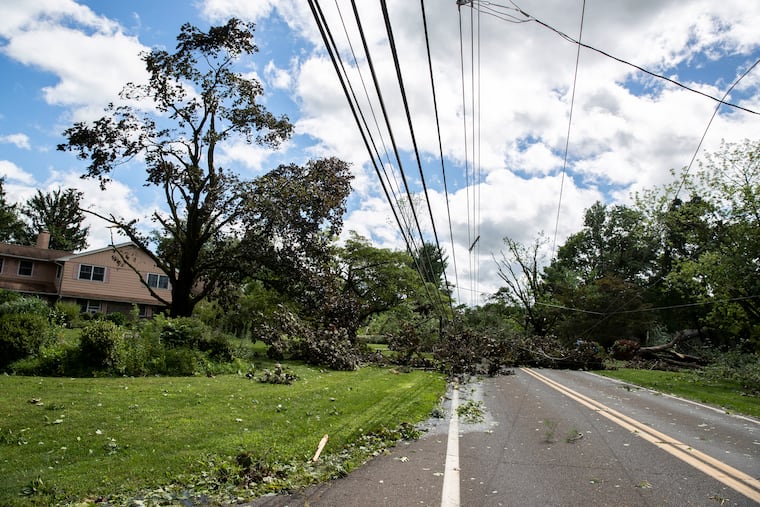Isaias could leave some customers in Pa., N.J. without power through the weekend
More than half the electric customers knocked out by Tropical Storm Isaias have already been reconnected. But some unfortunate customers may have to wait until Monday to get service restored.

Regional power companies, aided by out-of-state crews, on Wednesday raced to restore electrical service to more than 600,000 customers that was knocked out Tuesday by Tropical Storm Isaias, and say most customers will be back on line by Thursday or Friday. But some might be without power for days.
Peco, which serves Philadelphia and surrounding counties in Southeastern Pennsylvania, said it had restored service to about three-quarters of the 307,000 customers who lost power Tuesday, and expected 90% to be back online by Thursday.
But disappointment awaits some whose service is difficult to restore. Peco has given estimated restoration times as late as Sunday to some customers in hard-hit Chester and Bucks Counties, said Alexandra Coppadge, a Peco spokesperson.
Public Service Electric & Gas, the New Jersey utility that on Wednesday afternoon had restored power to more than 315,000 of the 575,000 customers who lost electricity, said it expected 85% of customers will be back online by Friday night. But some people at the end of remote circuits may not get power until Monday.
“We’ll still be doing work over the weekend, through Sunday and Monday, for the hardest-to-restore customers,” said Lauren Ugorji, a PSE&G spokesperson. The outliers include customers with backyard power lines that are difficult for repair crews to reach, or “nested outages” ― customers whose houses are still without power even after service has been restored to their block.
Power companies have learned from experience that it’s important not to promise too much when it comes to estimated restoration times — that customers are much more disappointed by missed deadlines.
Atlantic City Electric, which by Wednesday afternoon said it had restored more than 80% of the 200,000 customers who had lost power, said it had resumed service to some customers who previously were told they would have to wait until Thursday to get their power back on.
“We were able to restore power sooner than anticipated initially, and we hope to get as many folks back on as quickly as possible moving forward,” said Frank Tedesco, an ACE spokesperson. Fewer than 40,000 customers remained without service Wednesday afternoon.
The restoration effort is following a standard pattern where repair crews first fix outages affecting essential services, such as hospitals and public safety facilities, and then undo damage affecting the largest numbers of customers. That drives down outage numbers in the first 24 to 36 hours.
“Usually the first couple hundred thousand customers come back quickly, because they are more high-density areas or are vital customers such as hospitals, police stations, fire stations — those tend to happen,” said Coppadge of Peco.
“It’s always the smaller areas that are less populated, have fewer people on their system and may be living in areas that are severely impacted by the storm, that it just takes a little bit longer for us to get them back on,” Coppadge said. “But we definitely try to do so as quickly and safely as possible.”
The utilities said their own personnel were being assisted by crews from out-of-state utilities and contractors, but the effort was slowed because the storm had affected so many utilities in its path along the Eastern seaboard. Heavy rains and coastal winds up to 100 mph knocked out service to more than three million customers on Tuesday.
PSE&G said it had received assistance from crews from 14 states and Canada. Isaias is “among the strongest storms to hit our service territory in recent years,” the company said in a statement. The vast majority of PSE&G’s outages were in more densely populated Central and Northern New Jersey, according to its outage map, and the New York suburbs were particularly hard-hit.
ACE said it was receiving help from Canada, Florida, and Michigan, in addition to crews dispatched from utilities in Washington, D.C., and Chicago that are also owned by its parent company, Exelon.
Peco, which is also owned by Exelon, had 525 additional crews assisting on Wednesday and is requesting more.
» READ MORE: I stocked my fridge and freezer for the coronavirus pandemic. Do I have to throw it all out if my power went out?
» READ MORE: Isaias leaves destruction and thousands in Philly region without power: ‘The worst ... is yet to come’
Peco said that Tuesday’s tropical storm differed dramatically from the severe derecho windstorm that struck on June 3 largely without warning. That storm came and went quickly, and many customers did not realize the extent of the damage, but Peco lost more customers in one hour on June 3 — 400,000 — than were knocked out by Isaias.
In June, Peco was able to restore 90% of the outages in 36 hours, but some customers on the Main Line complained that they were without power for three of the sultriest days of the summer.
The company said it learned many lessons in June about managing an outage during the coronavirus pandemic, including keeping non-Peco work crews separate from Peco workers, and providing the out-of-state workers with such assistance as catered meals to help keep them isolated.
Coppadge said the importance of providing an accurate restoration time to customers has been reinforced during the pandemic because so many people are working, running businesses, or teaching their children at home.
“There is a heavy dependence on having power,” she said. “And what we learned from the past storm is how critical having an accurate assessment of when their power is going to be restored, so people can plan and work around that as we try to get their power on as quickly as we can.”